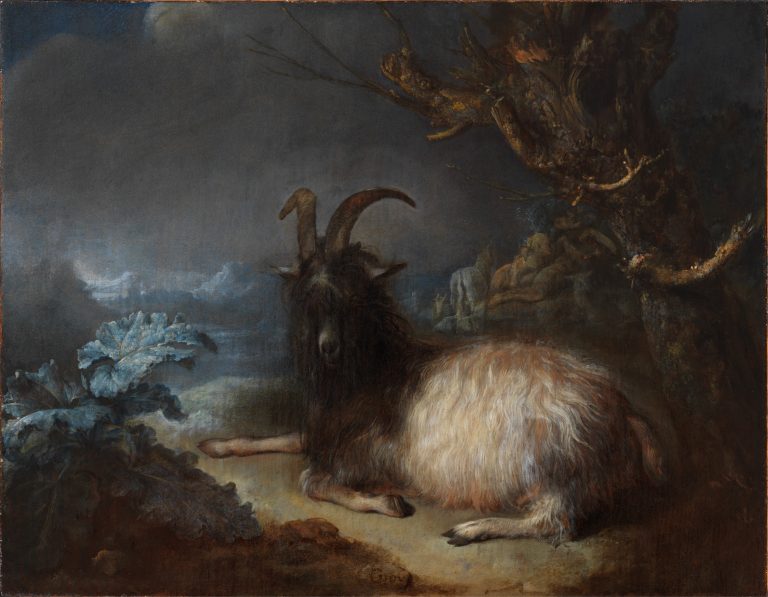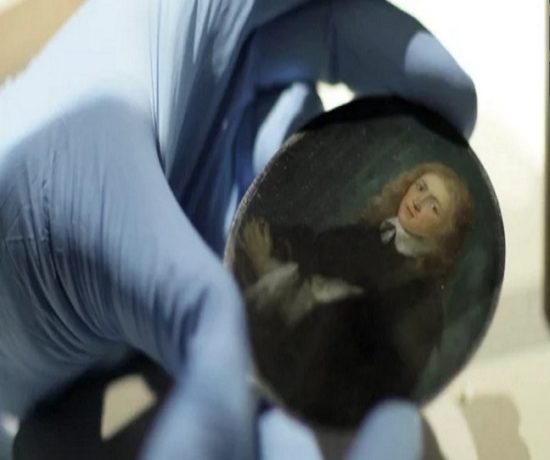Few goats have ever been featured as the primary subject of a painting, and certainly none has the whimsical personality of this one. Part of the goat’s charm as it looks out at the viewer with a combination of curiosity and patience, is its lackadaisical pose, with one front leg stretched out and one bent back. This unusual animal, which has black wool covering its head and neck and white on the rest of its body, is not a figment of Gerrit Dou’s imagination but an actual breed known as the Bagot Goat. How Dou came across such an exotic beast, which roamed the English countryside near Staffordshire, is not known, but its fascinating appearance clearly intrigued him and must have induced him to create this intriguing small panel painting.1
Dou undoubtedly based this image of a goat on a live model, but he also thought carefully about how he wanted the goat to appear in his painting. X-radiographs and infrared reflectograms indicate that he initially depicted the head in profile and then changed it to a frontal view during the paint process [(fig 1) and (fig 2)].2 In devising the goat’s pose, Dou seems also to have consulted an engraving of a recumbent goat (although of a different breed) by Marcus de Bije (1639–ca. 1690) (fig 3). The goat in De Bije’s print, based on a drawing by Paulus Potter (1625–54), also has one leg extended and one bent back.3
Dou situated the goat in a clearing between a gnarly tree and a large burdock plant,4 an evocative landscape setting that indicates he was not only interested in portraying this specific animal, but also in alluding to broader thematic concerns related to the traditional associations of a goat with lust and promiscuity. This interest is evident in the amorous scene of a shepherd and shepherdess that Dou introduced on the distant hillside. Dou based this figural grouping on Pastoral Couple with Goats, an engraving by Boetius Bolswert (ca. 1580–1633) after a design by Abraham Bloemaert (1566–1651), in which a half-nude shepherd is also shown resting his head on his left hand as he embraces his female companion near a herd of goats (fig 4). The burdock plant serves as a thematic counterpart to this ancillary scene, for its large vigorous leaves symbolize fecundity and reinforce the scene’s underlying theme of carnal desire.5
The associations of the goat with lust and promiscuity, which go back to classical antiquity, were also evident in the writings of Karel van Mander (1548–1606). In his Het Schilder-Boeck of 1604, Van Mander described the goat as unchaste and ruinous, likening this animal, which bites off and destroys young green buds of plants, to a whore who ruins young men.6 Hendrick Goltzius (1558–1617) alluded to the symbolism of lust associated with goats in his 1616 Fall of Man in the National Gallery of Art, Washington (fig 5).7 The goat also appears as a sign of carnal desire in pastoral landscapes such as Paris and Oenone, 1619, by Pieter Lastman (1583–1633), in which a shepherd gropes his bare-breasted companion (fig 6).8 Pieter Quast (1605/6–47) makes this allusion even more explicit in his Peasant Interior by depicting a reclining goat next to lovers rolling in the hay.9
Dou probably painted Goat in a Landscape during the first half of the 1660s, when he executed a number of single-figure nude scenes with similar landscape features.10 One closely related example is Nude Woman Bather from ca. 1660–65 in the Hermitage in St. Petersburg, in which a barren tree trunk likewise frames the scene to one side.11 He certainly executed it by 1665, when it was included in an exhibition of twenty-seven of Dou’s paintings owned by the distinguished Leiden collector Johan de Bye.12 The painting is listed as one of twenty-two works each displayed in a case (kas). Some of these cases must have opened with wings like a triptych, while others probably had a sliding lid; some of the covers of these containers were painted with still life images.13 Such a case would have compelled the viewer to come close to the painting to open its doors. The small-scale format and meticulous finish of Dou’s paintings continue to invite this type of visual intimacy today.14
Among the works in De Bye’s collection—which included market scenes, candlelit interiors, nude figures and self-portraits—are two paintings in the Leiden Collection dating from the early 1660s: not only Goat in a Landscape but also Young Woman in a Niche with a Parrot and Cage (GD-105). Interestingly, both of these paintings contain commentaries on human sexuality that are conjoined in an engraving that Jacob Matham (1571–1631), made in the 1580s after a design by Goltzius. Matham’s print, Libido (fig 7), depicts a small bird perched on the finger of a half-nude young woman as she walks next to a goat.15 It is quite possible that Dou and De Bye enjoyed this iconographic link between these two paintings, and brought them together as a delightful reference to the pervasive force of sexual desire in nature.

